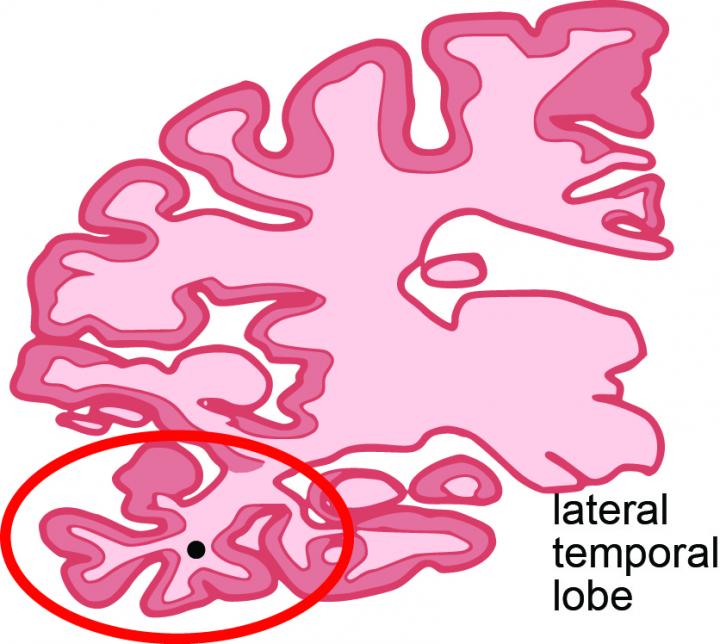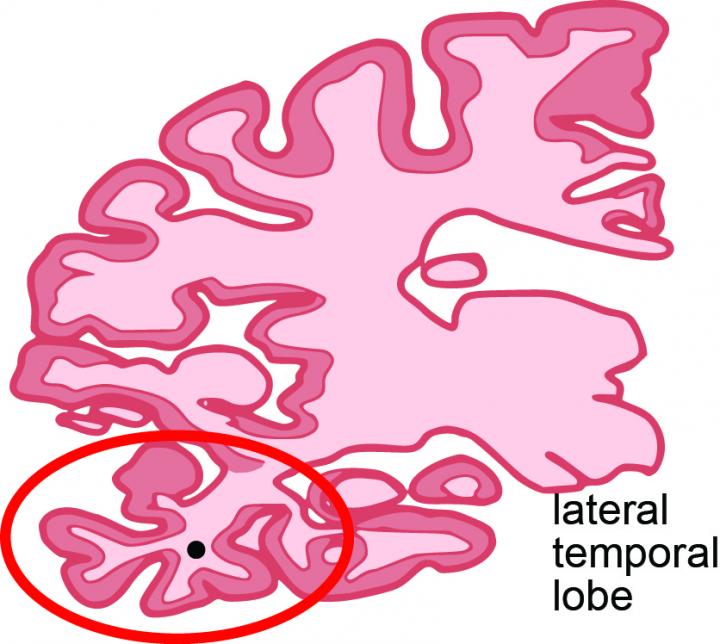
Credit: Coronal section of human brain indicating The lab of Shelley Berger, PhD, Perelman School of Medicine, University of Pennsylvania
PHILADELPHIA – Although certain genetic variants increase the risk of Alzheimer's disease (AD), age is the strongest known risk factor. But the way in which molecular processes of aging predispose people to AD, or become impaired in AD remains a mystery. A team of researchers from the Perelman School of Medicine at the University of Pennsylvania, publishing in Nature Neuroscience this week, profiled the epigenomic landscape of AD brains, specifically in one of the regions affected early in AD, the lateral temporal lobe. They compared these to both younger and elderly cognitively normal control subjects. The team described the genome-wide enrichment of a chemical modification of histone proteins that regulates the compaction of chromosomes in the nucleus (called acetylation of lysine 16 on histone H4, or H4K16ac for short).
Changes to the way H4K16ac is modified along the genome in disease versus normal aging brains may signify places for future drug development. Because changes in H4K16ac govern how genes are expressed, the location and amount of epigenetic alterations is called the "epigenetic landscape."
"This is the first time that we have been able to look at these relationships in human tissue by using donated postmortem brain tissue from the Penn Brain Bank," said Shelley Berger, PhD, a professor of Cell and Developmental Biology in the Perelman School of Medicine and a professor of Biology in the School of Arts and Sciences. "Our results establish the basis for an epigenetic link between aging and Alzheimer's disease."
Berger, also the director of the Penn Epigenetics Institute, Nancy Bonini, PhD, a professor of Biology, and Brad Johnson, MD, PhD, an associate professor of Pathology and Laboratory Medicine, are co-senior authors of the new study.
H4K16ac is a key modification in human health because it regulates cellular responses to stress and to DNA damage. The team found that, while normal aging leads to increasing H4K16ac in new positions along the genome and an increase in where it is already present, in great contrast, AD entails losses of H4K16ac in the proximity of genes linked to aging and AD. In addition, the team discovered an association between the location of H4K16ac changes and genetic variants identified in prior AD genome-wide association studies.
A three-way comparison of younger, older, and AD brain tissue revealed a specific class of H4K16ac changes in AD compared to normal age-established changes in the brain. This finding indicates that certain normal aging changes in the epigenome may actually protect against AD and when these goes awry, a person may become predisposed to AD.
"These analyses point to a new model of Alzheimer's disease. Specifically it appears that AD is not simply an advanced state of normal aging, but rather dysregulated aging that may induce disease-specific changes to the structure of chromatin – the combination of histone proteins and DNA." said first author Raffaella Nativio, PhD, a postdoctoral fellow in Berger's lab.
Accumulation of intercellular amyloid plaques and neurofibrillary tangles are the two hallmarks of AD that drive the death of neurons and the corresponding loss of cognitive abilities. However, expression of plaques and tangles is very late in the development of AD, while epigenome alterations might occur much earlier and represent targets to attack with medications.
The authors emphasized that this study does not suggest a cure for AD, but rather the possibility of finding ways to prevent nerve cell death and enhance the quality of aging. Their upcoming experiments aim to discover the physiological changes that cause the decrease of H4K16ac specifically in AD brains, but not in normal-aged brains.
###
This work was funded by the National Institutes of Health (R01-NS078283, AG10124, AG175)
Other coauthors included Greg Donahue, Amit Berson, Yemin Lan, Alex Amlie-Wolf, Jon B. Toledo, Sager J. Gosai, Brian D. Gregory, John Q. Trojanowski, and Li-San Wang, all from Penn.
Penn Medicine is one of the world's leading academic medical centers, dedicated to the related missions of medical education, biomedical research, and excellence in patient care. Penn Medicine consists of the Raymond and Ruth Perelman School of Medicine at the University of Pennsylvania (founded in 1765 as the nation's first medical school) and the University of Pennsylvania Health System, which together form a $7.8 billion enterprise.
The Perelman School of Medicine has been ranked among the top five medical schools in the United States for the past 20 years, according to U.S. News & World Report's survey of research-oriented medical schools. The School is consistently among the nation's top recipients of funding from the National Institutes of Health, with $405 million awarded in the 2017 fiscal year.
The University of Pennsylvania Health System's patient care facilities include: The Hospital of the University of Pennsylvania and Penn Presbyterian Medical Center — which are recognized as one of the nation's top "Honor Roll" hospitals by U.S. News & World Report — Chester County Hospital; Lancaster General Health; Penn Medicine Princeton Health; Penn Wissahickon Hospice; and Pennsylvania Hospital – the nation's first hospital, founded in 1751. Additional affiliated inpatient care facilities and services throughout the Philadelphia region include Good Shepherd Penn Partners, a partnership between Good Shepherd Rehabilitation Network and Penn Medicine, and Princeton House Behavioral Health, a leading provider of highly skilled and compassionate behavioral healthcare.
Penn Medicine is committed to improving lives and health through a variety of community-based programs and activities. In fiscal year 2017, Penn Medicine provided $500 million to benefit our community.
Media Contact
Karen Kreeger
[email protected]
215-459-0544
@PennMedNews
http://www.uphs.upenn.edu/news/





